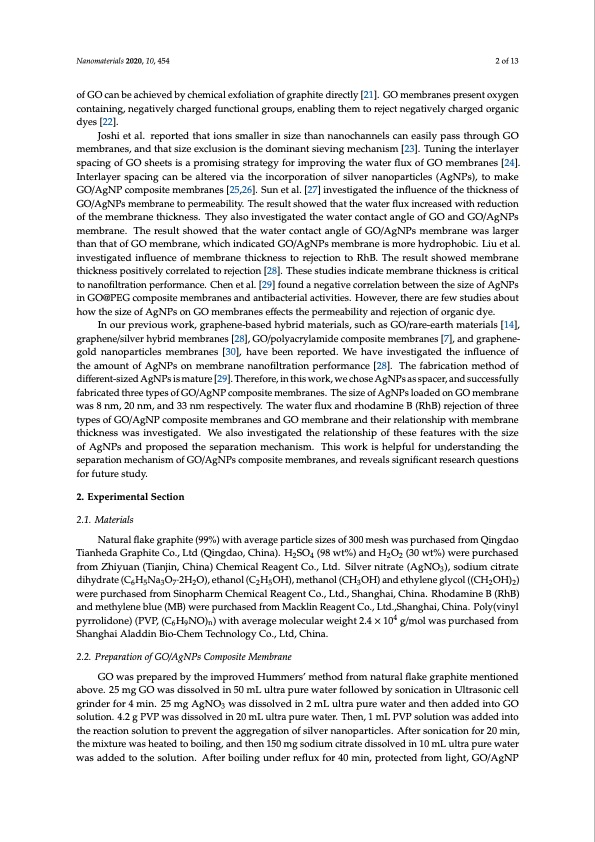
PDF Publication Title:
Text from PDF Page: 002
Nanomaterials 2020, 10, 454 2 of 13 of GO can be achieved by chemical exfoliation of graphite directly [21]. GO membranes present oxygen containing, negatively charged functional groups, enabling them to reject negatively charged organic dyes [22]. Joshi et al. reported that ions smaller in size than nanochannels can easily pass through GO membranes, and that size exclusion is the dominant sieving mechanism [23]. Tuning the interlayer spacing of GO sheets is a promising strategy for improving the water flux of GO membranes [24]. Interlayer spacing can be altered via the incorporation of silver nanoparticles (AgNPs), to make GO/AgNP composite membranes [25,26]. Sun et al. [27] investigated the influence of the thickness of GO/AgNPs membrane to permeability. The result showed that the water flux increased with reduction of the membrane thickness. They also investigated the water contact angle of GO and GO/AgNPs membrane. The result showed that the water contact angle of GO/AgNPs membrane was larger than that of GO membrane, which indicated GO/AgNPs membrane is more hydrophobic. Liu et al. investigated influence of membrane thickness to rejection to RhB. The result showed membrane thickness positively correlated to rejection [28]. These studies indicate membrane thickness is critical to nanofiltration performance. Chen et al. [29] found a negative correlation between the size of AgNPs in GO@PEG composite membranes and antibacterial activities. However, there are few studies about how the size of AgNPs on GO membranes effects the permeability and rejection of organic dye. In our previous work, graphene-based hybrid materials, such as GO/rare-earth materials [14], graphene/silver hybrid membranes [28], GO/polyacrylamide composite membranes [7], and graphene- gold nanoparticles membranes [30], have been reported. We have investigated the influence of the amount of AgNPs on membrane nanofiltration performance [28]. The fabrication method of different-sized AgNPs is mature [29]. Therefore, in this work, we chose AgNPs as spacer, and successfully fabricated three types of GO/AgNP composite membranes. The size of AgNPs loaded on GO membrane was 8 nm, 20 nm, and 33 nm respectively. The water flux and rhodamine B (RhB) rejection of three types of GO/AgNP composite membranes and GO membrane and their relationship with membrane thickness was investigated. We also investigated the relationship of these features with the size of AgNPs and proposed the separation mechanism. This work is helpful for understanding the separation mechanism of GO/AgNPs composite membranes, and reveals significant research questions for future study. 2. Experimental Section 2.1. Materials Natural flake graphite (99%) with average particle sizes of 300 mesh was purchased from Qingdao Tianheda Graphite Co., Ltd (Qingdao, China). H2SO4 (98 wt%) and H2O2 (30 wt%) were purchased from Zhiyuan (Tianjin, China) Chemical Reagent Co., Ltd. Silver nitrate (AgNO3), sodium citrate dihydrate (C6H5Na3O7·2H2O), ethanol (C2H5OH), methanol (CH3OH) and ethylene glycol ((CH2OH)2) were purchased from Sinopharm Chemical Reagent Co., Ltd., Shanghai, China. Rhodamine B (RhB) and methylene blue (MB) were purchased from Macklin Reagent Co., Ltd.,Shanghai, China. Poly(vinyl pyrrolidone) (PVP, (C6H9NO)n) with average molecular weight 2.4 × 104 g/mol was purchased from Shanghai Aladdin Bio-Chem Technology Co., Ltd, China. 2.2. Preparation of GO/AgNPs Composite Membrane GO was prepared by the improved Hummers’ method from natural flake graphite mentioned above. 25 mg GO was dissolved in 50 mL ultra pure water followed by sonication in Ultrasonic cell grinder for 4 min. 25 mg AgNO3 was dissolved in 2 mL ultra pure water and then added into GO solution. 4.2 g PVP was dissolved in 20 mL ultra pure water. Then, 1 mL PVP solution was added into the reaction solution to prevent the aggregation of silver nanoparticles. After sonication for 20 min, the mixture was heated to boiling, and then 150 mg sodium citrate dissolved in 10 mL ultra pure water was added to the solution. After boiling under reflux for 40 min, protected from light, GO/AgNPPDF Image | Graphene Oxide Nanofiltration Membranes Silver Nanoparticles

PDF Search Title:
Graphene Oxide Nanofiltration Membranes Silver NanoparticlesOriginal File Name Searched:
nanomaterials-10-00454-v2.pdfDIY PDF Search: Google It | Yahoo | Bing
Turbine and System Plans CAD CAM: Special for this month, any plans are $10,000 for complete Cad/Cam blueprints. License is for one build. Try before you buy a production license. More Info
Waste Heat Power Technology: Organic Rankine Cycle uses waste heat to make electricity, shaft horsepower and cooling. More Info
All Turbine and System Products: Infinity Turbine ORD systems, turbine generator sets, build plans and more to use your waste heat from 30C to 100C. More Info
CO2 Phase Change Demonstrator: CO2 goes supercritical at 30 C. This is a experimental platform which you can use to demonstrate phase change with low heat. Includes integration area for small CO2 turbine, static generator, and more. This can also be used for a GTL Gas to Liquids experimental platform. More Info
Introducing the Infinity Turbine Products Infinity Turbine develops and builds systems for making power from waste heat. It also is working on innovative strategies for storing, making, and deploying energy. More Info
Need Strategy? Use our Consulting and analyst services Infinity Turbine LLC is pleased to announce its consulting and analyst services. We have worked in the renewable energy industry as a researcher, developing sales and markets, along with may inventions and innovations. More Info
Made in USA with Global Energy Millennial Web Engine These pages were made with the Global Energy Web PDF Engine using Filemaker (Claris) software.
Infinity Turbine Developing Spinning Disc Reactor SDR or Spinning Disc Reactors reduce processing time for liquid production of Silver Nanoparticles.
| CONTACT TEL: 608-238-6001 Email: greg@infinityturbine.com | RSS | AMP |